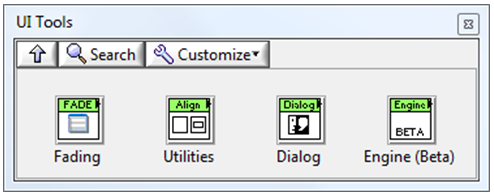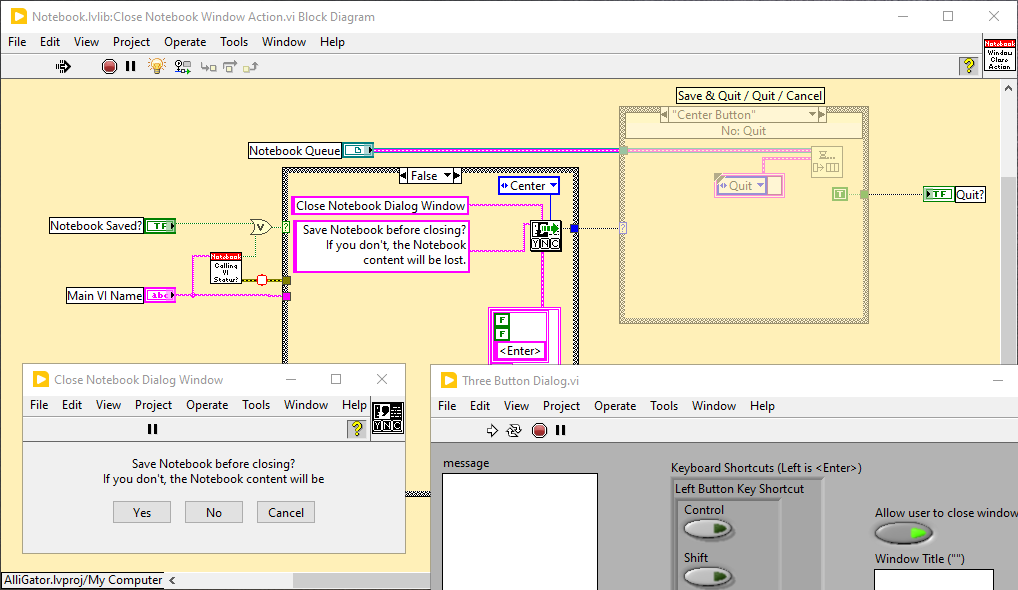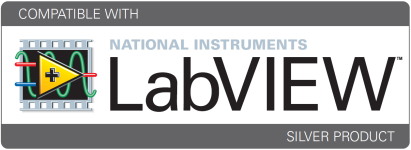Search the Community
Showing results for tags 'dialog'.
-
View File UI Tools UI Tools v1.4.0 Copyright © 2009-2016, François Normandin All rights reserved. Author:François Normandin Contact Info: Contact via PM on www.lavag.org LabVIEW Versions: Created and tested with LabVIEW 2012 Dependencies: OpenG Application Control Library >= 4.1.0.7 OpenG Array Library >= 4.1.1.14 OpenG File Library >= 4.0.1.22 OpenG LabVIEW Data Library >= 4.2.0.21 OpenG String Library >= 4.1.0.12 LAVA Palette >= 1.0.0.1 Description: This package contains tools for designing user interfaces. A first palette helps create special effects using transparency of front panel. Using them allows to quickly create fade-ins or outs using linear or exponential variation of the intensity. A second palette contains VIs to calculate the position of GObjects for many purposes like alignment, snap, mouse follow, etc. A third palette contains VIs to create dialog boxes based on class instances. "Simple Error Dialog" and "Simple Selection List" are featured with or without backrground blackening effect. A fourth palette includes some VIs to move objects programmatically on the front panel, using a basic deceleration algorithm to provide an impression of a smooth movement. The packaged VIs are all namespaced using a suffix “__lava_lib_ui_tools” which should not conflict with any of your own code. Includes: Front Panel Transparency (Fade In & Fade Out) Utilities (Alignment, Snap) Dialog (OOP based, extensible) Engine (Beta) for object movement Instructions: This package is distributed on the LabVIEW Tools Network (version 1.3) and updates are on LAVA (1.4). It can be installed directly in the addon folder of any LabVIEW version from 2012 to now. The addon installs automatically under the LAVA palette of the addon submenu. License: Distributed under the BSD license. Support: If you have any problems with this code or want to suggest features, please go to www.lavag.org and navigate to the discussion page. Submitter Francois Normandin Submitted 09/21/2009 Category LabVIEW Tools Network Certified LabVIEW Version
- 54 replies
-
- 3
-

-
- alignement
- dialog
-
(and 3 more)
Tagged with:
-
I have an application where the "second monitor" of the Windows computer is actually a projector, used in running a test. I display test patterns on this monitor, but the User can't see them. The problem I am having is ensuring that all dialog boxes, including error dialogs, show up on the primary screen always. But, intermittently, they start to show up on the projector. I cannot seem to discover how Windows/LabVIEW decides which monitor to show dialogs on. Does anyone know?
-
I am staring at this: which shows a snapshot of 3 VIs, two of them being in vi.lib/Utility/error.lib VIs (visible FP), the other one being a subVI in a library of mine. The snapshot illustrates the puzzling situation that I am encountering: Three Button Dialog.vi, whose state is idle as is clear from the snapshot (but is also confirmed by the LabVIEW Task Manager), is however "running" as indicated by the green arrow in the calling VI (whose BD is shown in the back). The "Close Notebook Dialog Window" is nothing but the Three Button Dialog CORE.vi of the error.lib library, and is also idle. In other words, the calling subVI is never stepping out of this situation and the only way for me to recover is to abort the VI. Question: how is THIS even possible? Background information: First of all, I wished I could boil this down to a simple example that I could share, but I haven't been able to reproduce this yet in a bare bone project. Now, the weird thing is that this situation occurred after what I thought would be a simple refactoring of my application, namely dynamically launching my consumer loop, which itself launches the Notebook VI whose subVI is now unresponsive. Before: Main launches Notebook dynamically. User closes Main. Only Notebook remains live. User clicks Notebook's "close box" which call the 3-button dialog. User clicks "No", Notebook closes. After: Main launches Consumer loop VI dynamically. Consumer opens Notebook dynamically. User closes Main which sends a "Quit" message to the Consumer loop, shutting it down. Only Notebook remains live. User clicks Notebook's "close box" which call the 3-button dialog 3-button dialog is idle, Notebook is stuck waiting for it to finish. Something is going on (or rather is not). What could it be? LabVIEW 2021 SP1 64-bit Windows 10 Edit: I forgot to mention that none of the VIs above are re-entrant and that the 3-button dialog CORE.vi is supposed to run as a modal window.
-
Version 1.4.1
17,413 downloads
UI Tools v1.4.0 Copyright © 2009-2016, François Normandin All rights reserved. Author:François Normandin Contact Info: Contact via PM on www.lavag.org LabVIEW Versions: Created and tested with LabVIEW 2012 Dependencies: OpenG Application Control Library >= 4.1.0.7 OpenG Array Library >= 4.1.1.14 OpenG File Library >= 4.0.1.22 OpenG LabVIEW Data Library >= 4.2.0.21 OpenG String Library >= 4.1.0.12 LAVA Palette >= 1.0.0.1 Description: This package contains tools for designing user interfaces. A first palette helps create special effects using transparency of front panel. Using them allows to quickly create fade-ins or outs using linear or exponential variation of the intensity. A second palette contains VIs to calculate the position of GObjects for many purposes like alignment, snap, mouse follow, etc. A third palette contains VIs to create dialog boxes based on class instances. "Simple Error Dialog" and "Simple Selection List" are featured with or without backrground blackening effect. A fourth palette includes some VIs to move objects programmatically on the front panel, using a basic deceleration algorithm to provide an impression of a smooth movement. The packaged VIs are all namespaced using a suffix “__lava_lib_ui_tools” which should not conflict with any of your own code. Includes: Front Panel Transparency (Fade In & Fade Out) Utilities (Alignment, Snap) Dialog (OOP based, extensible) Engine (Beta) for object movement Instructions: This package is distributed on the LabVIEW Tools Network (version 1.3) and updates are on LAVA (1.4). It can be installed directly in the addon folder of any LabVIEW version from 2012 to now. The addon installs automatically under the LAVA palette of the addon submenu. License: Distributed under the BSD license. Support: If you have any problems with this code or want to suggest features, please go to www.lavag.org and navigate to the discussion page.- 6 reviews
-
- 3
-

-

-
- effects
- user interface
-
(and 3 more)
Tagged with:
-
Hi, I'm writing a LabVIEW application using the Actor Framework. This is the first time that I have used the framework and I need some advice regarding application architecture. My apologies if this is a basic question! How is a settings dialog box best implemented? In the past in non-Actor Framework applications I have loaded the configuration from a functional global variable, displayed the settings dialog, then written the updated settings back to the functional global. I'm not sure this would work correctly (or optimally) within the context of the Actor Framework, though. My application uses the template generated by Create Project -> Actor Framework. The top-level Actor manages the user interface. Two child Actors control separate pieces of hardware. The top-level actor must read a saved configuration from an INI file when the application starts, and save the final configuration back to the INI file on exit. Instinctively I think it would be best for each child actor to maintain its own settings, as a cluster in its class private data. Ideally I don't want to have to keep a separate instance of the two clusters of settings in the top-level Actor's private data in order to populate a settings dialog; this duplication seems unnecessary. The only way I can think of to make this work is as follows. At application start 1. Top-level Actor reads settings from INI file. 2. Send messages to both child actors with the new settings, and tell them to apply those settings to their private data. 3. Each child Actor should respond to acknowledge that the private data has been updated. To update the settings using a dialog box 1. Send a message from the top-level Actor to each child Actor to ask them to send their settings to the top-level Actor. 2. Wait for both child Actors to reply. 3. Display the dialog box. 4. If the user clicked 'Ok' and not 'Cancel', send messages to both actors with the new settings, and tell them to apply those settings to their private data. 5. Each child Actor should respond to acknowledge that the private data has been updated. On exit 1. Send a message from the top-level Actor to each child Actor to ask them to send their settings to the top-level Actor. 2. Wait for both child Actors to reply. 3. The top-level Actor writes the settings to the INI file. This doesn't seem like a sensible approach, though. Waiting for message replies sounds like the wrong thing to do. I wouldn't know where in the block diagram to implement this scheme, either. Can anyone offer me any advice? There must be a fairly standard way of doing this that I'm missing! Thanks in advance, Chris --- Dr. Chris Empson Robot Screening and Instrumentation Specialist School of Chemistry University of Leeds UK CLD
- 6 replies
-
- dialog
- architecture
-
(and 2 more)
Tagged with:
-
Hello forum LAVA-ites, I am attempting to write a Tools Menu item to slot into the IDE. The intent of this "Tools" VI is that it determines the application instance that launched it and dynamically run a VI in that application instance so that the launched VI can access VIs in that instance. This is basically a custom Unit Testing tool that looks for particular VIs in the project that houses the application instance. I was attempting to use the App.MenuLaunchApp property in this "Tools" VI so that I could wire up an Open VI Reference node with the right application instance and the name of the VI to run dynamic VI to run. I added an extra indicator on the launched VI to show what application context it is running in. If I have a VI open from a Project and then launch the "Tools" VI from the Tools menu, then the dynamically run VI indicator shows "My Computer" (referring to the project housing the application instance). However - if I launch the "Tools" VI from the Tools Menu while Project Explorer is showing then the dynamic VI launches in the NI.LV.Dialog irrespectively (the indicator on the front panel of this VI shows this). Is this expected behaviour? Is there a way around this so that the dynamic VI gets loaded into the right application instance even if launched from Project Explorer? Thanks in advance.
- 8 replies
-
- 1
-

-
- tools menu
- dialog
-
(and 1 more)
Tagged with:
-
Hi, I am facing a weird situation and would like to get your insights. My application is quite large (>1000 VIs). When I run it, an initialization phase takes place, and around 10 or 20 objects are created (LVOOP). Most of these objects start their engine using the Open VI Reference and then the Run method. If they encounter any warning during that phase, they enqueue a message to display, and a dedicated VI keeps checking this queue and opens a LV Dialog (with just a OK button) when it finds an element. The purpose is to allow the initialization phase to continue instead of waiting for the user to acknowledge the window. Then when the init phase is complete, the user can just acknowledge all the dialogs one after another. (usually there is like 1 or 2, not much more). I ran my code this morning and was surprised to see that the init phase would still wait for me to acknowledge the dialog. A few probes showed me that the application was stuck in one of the Open VI Reference call. After I acknowledge the window, it would process normally. I am wondering what is causing this behavior and whether it is a known issue. Could it be related to the fact that the Dialog is modal and somehow holds the thread in which the Open VI Reference executes? This is weird, because other complex operations (connecting to a database,...) manage to execute while the dialog is open... Thank you very much for your help Emmanuel
-
Hi all, I'm somewhat new to Labview so excuse any ineptitude that may arise. I have a program that is centered around an array of Devices - they are various different object types that descend from an abstract Device class. I'm trying to make a VI that can call the correct method VI for a given device in this main list (in an object oriented way, of course). So far this has been fine for most VIs, but now I'm trying to make an overridden VI in each class that opens when called, like a dialog box. As of right now, calling the "Display Info.vi" (the VI in question) on a given device opens the Display Info VI from the Device class, which is basically just a blank, unimplemented VI and therefore useless. Are there some settings I need to check to enforce polymorphic behavior on this VI? Thank you for any info you can provide!
- 5 replies
-
- oop
- polymorphism
-
(and 1 more)
Tagged with:
-
I would like to see OpenG version of the default 1,2 and 3 button dialogs offered by LabVIEW with an optional timeout. The purpose of such dialog is that it informs the user and allows him to take some action. If the user does not respond in time a default action would be taken. The timeout should default to '-1' meaning a timeout would never occure, the time-out would be configured in seconds, and the default button would show 'button-name[xxx]' with xxx in seconds until that action will be taken. Any thoughts? I'll try to come up with some protypes tomorrow. (perhaps an express VI) Ton








